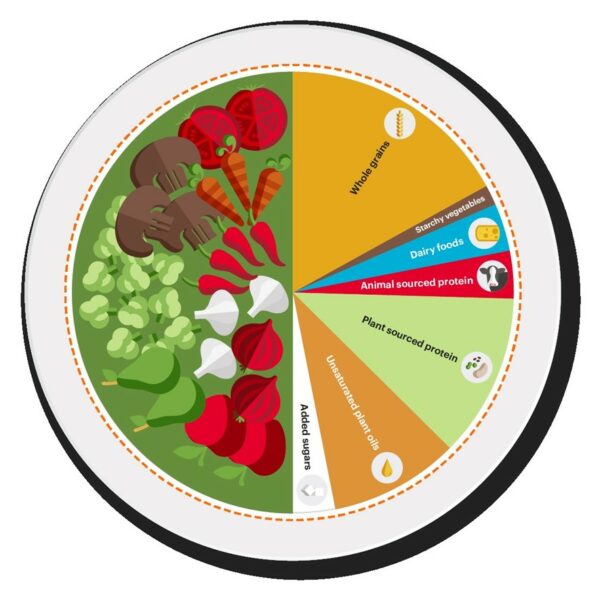The Lancet Planetary Health Diet
Is there a way to eat that not only reduces the risk of disease and promotes well-being, but is also sustainable? Could a certain diet provide enough food for the 9.8 billion people estimated to be living on earth by 2050? This was the challenge first taken on in 2019 by the EAT-Lancet Commission, comprised of top scientists from around the globe.
Combining analysis of more than 30 years of the best available nutritional studies and randomized trials with planetary boundaries for key environmental systems and processes, in 2023, the Commission found it to be “an achievable reality that would improve the health and well-being of billions and allow us to pass on to our children a viable planet.” However, cautions Walter Willett, MD, professor of epidemiology and nutrition at Harvard’s T.H. Chan School of Public Health and Commission co-chair: “It won’t be easy and will take the engagement of almost everyone.”
Implementing and Following the Planetary Health Diet
The basics of the Planetary Health Diet include:
- No more than one serving of protein, like poultry, fish, red meat or eggs, and one serving of dairy per day. Focus on fruits and vegetables (at least five servings daily), nuts, legumes (dry beans, lentils and peas), whole grains and plant oils. “We emphasize plant-based protein sources to help prevent major health issues such as diabetes, cardiovascular disease, cancer and dementia,” explains Willett. “We also explored if there is a certain amount of red meat, for example, that that could be consumed while still remaining at low risk for disease. One serving a week (about 14 grams daily) met our criteria, but increasing to two servings weekly made a significant, and unacceptable, increase in the risk for type 2 diabetes.”
- Nutrient-dense items such as nuts and legumes are also emphasized to ensure food production and consumption practices will not exceed the earth’s ecological limits. Foods sourced from animals have a relatively high environmental footprint per serving compared to other food groups which impacts greenhouse gas emissions, land use and biodiversity loss, according to the Commission.
- Among major protein sources, lentils are considered the healthiest, with the highest ratio of polyunsaturated fat to saturated fat, followed by tofu, almonds and salmon.
- Less healthy foods to avoid include red meat, eggs, dairy, refined grains and sugar-sweetened beverages.
Variety Through a Flexible Diet
“It really comes down to a flexitarian diet. There’s incredible variety in the ways you can put it together and keep animal sources of protein to a minimum,” says Willett. His only asterisk: “Lower vitamin B12 levels can occur when less than two servings of animal protein is consumed daily, with serious health consequences.” He recommends getting adequate amounts of the vitamin through either supplements or fortified foods.
Only a few parts of the world currently meet scientific targets for the planetary health diet, and the U.S. in particular will need to significantly decrease consumption of animal proteins. “Higher intakes of vegetables, fruits, legumes, and especially nuts and whole grains would be desirable for almost every country, preventing about 11 million deaths per year,” says Willett. “It is not a question of all or nothing, but gradually making small changes for a large and positive impact.”

Rooting for Vegetables
Bring the benefits of plant-forward eating to your table with seasonal root vegetables this winter. These veggies are high in vitamins and nutrients, and low in calories. Many root vegetables listed below may have anti-inflammatory, antioxidant and cholesterol lowering properties as well. Enjoy these versatile veggies:
- Allium Bulbs (onions, shallots, garlic). Roast or caramelize for pizza garnishes, bread toppings and quesadilla fillings.
- Avocados. At their creamy best for use in wraps, salads, and dips, including guacamole.
- Belgian Endive. Chop for salads; braise whole or brush with a vinaigrette and grill for side dish.
- Beets. Grate to sprinkle in salads or on sandwiches; sautee or roast with garlic and olive oil for side dish.
- Broccoli/Broccoli Rabe/Broccolini. Use in pasta dishes and winter salads; puree for soup.
- Brussels Sprouts. Roast for optimal flavor and serve as appetizer, side dish, even a pizza topping.
- Carrots (white, yellow, purple, red and orange varieties). Eat raw with yogurt-based dip; steam, boil or roast for side dish.
- Celeriac (celery root). Sub for potatoes in soups and stews; blend for creamy sauce; grate into salad.
- Chayote. Add to salads; use as soup base.
- Fennel. Chop raw and freeze for use in soups and stews.
- Kale, Collards, Mustard and Turnip Greens. Roast or boil until tender and dress for salad while still warm.
- Parsnips. Eat raw; boil lightly; roast with carrots and potatoes.
- Rutabagas. Use in place of or in addition to turnips and potatoes.
- Sunchokes (Jerusalem artichokes). Serve in salads; puree as base for main course; roast with olive oil for side dish.
- Sweet Potatoes. Make healthy fries by quartering, drizzling with olive oil and baking at 400 degrees for 40-60 minutes; steam chunks and mash; bake whole and unpeeled.
- Turnips. Bake, boil or steam like a potato; shred for coleslaw; julienne as garnish.
- Winter Squash (butternut, acorn, delicata, kambocha, spaghetti and pumpkin varieties). Steam or microwave as low-calorie alternative to pasta; roast, stir fry or puree for soups.
Sources: Have a Plant, Spruce Eats, Datassential
